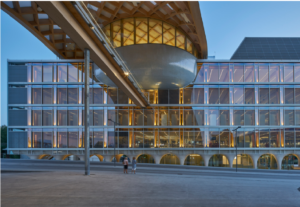Renewable energy resources commonly used in building construction include solar, wind, geothermal and biomass. The use of these sources depends on a number of factors such as availability, requirements and financial reasons.
Solar electric photovoltaic energy
Solar PV is used to convert sunlight into electricity. These systems are assembled modular arrays that can be mounted on the roof or any vertical surface of the building. A power inverter is used to convert the direct current into a grid quality alternating current. The solar cells made of silicon, usually flat in the design are most efficient in converting solar energy into electric power.
Building integrated photovoltaic (BIPV) products are most suited for applications on existing buildings. This technology can be fitted into the surfaces as tiles, shingles or can be used as glazing of the windows and skylights. In other words, these products are hidden into the elements of the structure.
Solar thermal energy
Solar thermal is a cost-competitive way to generate hot water systems and ventilation preheating systems. It eliminates the cost of electricity or fossil fuels which helps in controlling environmental impacts.
Solar hot water systems: These systems use a collector to absorb and transfer heat from the sun to water, which could be stored in a tank until needed. In general, solar water systems require low maintenance and are very reliable.
Solar ventilation preheating systems: These systems are used where application is needed for high volumes of ventilated air. The sun warms the collector surface, from where the heat is then conducted to a thermal boundary layer of air. Fans are used to draw the boundary layer before the heat escapes through convection. These systems are low cost, reliable, low maintenance and highly efficient.

Geothermal energy
Geothermal technology uses heat from the center of the earth. Shallow ground or the upper 3 m layer of the earth’s surface maintains the temperature of 10o – 16o C. This heat is tapped to provide heating and cooling systems for homes and buildings. Deeper and warmer geothermal sources can be used directly through advanced technologies. It can be used for heat and electricity generation. Geothermal pumps are the most common geothermal energy technology used in buildings
Wind energy
Wind energy is generated by uneven solar heating of the earth’s surface. This motion energy can be harnessed by modern wind turbines to generate electricity. Before installing a wind turbine, it must be ensured that the wind resource in a specific location is adequate. Some issues need to be carefully considered such as maintaining the building structure, noise and added cost in the construction of the project.
Bio-energy
Organic matter such as plants, residue from agriculture, organic components of municipal and industrial wastes; all these types of biomasses can be used to generate fuels, chemicals, and power. Biomass technologies break down organic matter to release stored energy from the sun. Bio-fuels and bio-power can be used to generate heat and electricity for buildings.
Aquatis Aquarium

The components of the exterior façade of the building have been upgraded to improve thermal performance. The material used is economical. The link to services industries helps in the incineration of household waste which enables the use of renewable energy with low greenhouse gas emissions. Air conditioning in the whole complex is achieved by high-performance equipment that functions with environmentally friendly fluids. Central management of the two buildings optimizes the synergies of two types of users ensuring every reliable functioning of technical equipment as well as maintaining energy efficiency.
Museum Of Contemporary Art & Planning Exhibition

The project is a combination of art and technological components. Thermal insulation and efficient sun shading, it is not only an architectural landmark but also an ecological and sustainable benchmark project.
Swatch and Omega Campus

The structure has many ecological benefits of wood along with numerous other eco-friendly strategies. To achieve low energy consumption and a better working environment, technologies such as radiative cooling and heating is achieved through activated ceiling panels. Groundwater is used as the heat source that gives a significant reduction of both heating and cooling energies. The roof is equipped with photovoltaic panels.

